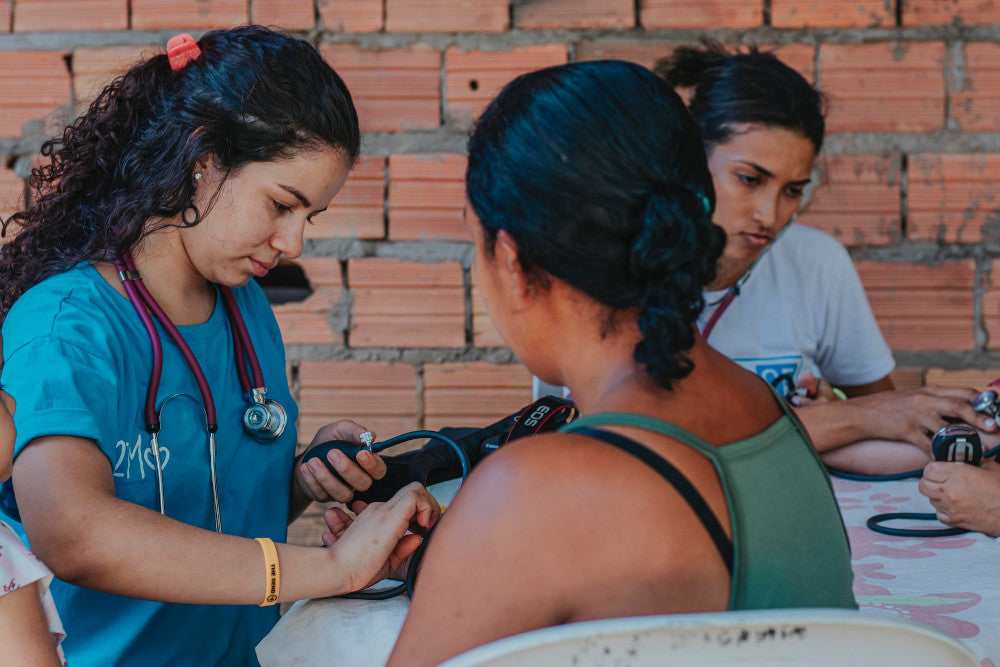
Most nurses wear medical scrubs to work at a hospital, lab, or doctor’s office. Scrubs serve as a practical uniform to easily identify the medical staff at any institution. Nurses in a surgical assistant role commonly wear a scrub cap as well as a face mask to provide protection for patients. Everything a nurse wears, from their shoes to their jewelry, has a practical purpose and is designed to keep the nurse and their patients safe.
Most hospitals and doctor’s offices supply a dress code for all staff, including nurses. This will tell you what cut and color of medical scrubs to wear, for example. Some dress codes also specify the type of footwear allowed, such as nursing shoes vs clogs. In some environments such as an operating room, safety protocols will also dictate what a nurse wears, such as a surgical gown over top of their scrubs.
Panaprium is independent and reader supported. If you buy something through our link, we may earn a commission. If you can, please support us on a monthly basis. It takes less than a minute to set up, and you will be making a big impact every single month. Thank you!
Scrubs

The daily uniform for most nurses at hospitals, doctor's offices, or even in-home services is a pair of scrubs. Scrubs include a loose, short-sleeved, rather boxy shirt and a pair of loose, usually drawstring-style matching pants. The loose fit allows easy movement for a job that often requires physically demanding tasks like lifting and rolling patients.
Scrubs got the name because putting on this uniform originally served as part of the process of “scrubbing in” or sterilizing hands and tools in preparation for medical activities. You can find out about the history of scrubs in this article from the Medical Device News.
This medical uniform often includes other special design features for a nurse, too. Your scrubs will incorporate many large pockets perfect for placing items you need as you rush to a patient’s bedside. In fact, scrub tops often have as many as five pockets, and the pants may incorporate cargo-pant-style pockets on the outside of the legs as well.
The specific cut or style of scrubs you need, as well as the particular shade of color worn by your department or office, will vary a lot.
Color-Coded Uniforms

Just like military or police uniforms, scrubs typically have a particular color and design. If you work at a hospital, the hospital may assign all staff to wear matching scrubs in the same color, or the healthcare facility may assign a different color of scrubs for staff in each department, such as the ER vs the maternity ward.
Using a color-coded system helps staff easily identify each other even in the middle of a crisis. But the primary reason for the matched uniform is patient safety, as Catalina Island Medical Center explains here. The matching staff scrubs allow patients to find help because they can spot colorful scrubs even in a crowded area, and identify where to get help.
In some cases, stylistic designs on scrubs, like adding a stripe to a sleeve, will indicate nurses at different levels of responsibility, such as a charge nurse for a ward.
If you work at a small private practice with limited staff, you may have more freedom in choosing the color and design of your scrubs. In this case, you can find scrubs in all kinds of cute patterns, like teddy bears or kittens!
Sanitary Fabric

Another reason scrubs work so well in the medical community is that they often contain a special fabric with a slick surface that allows dangerous fluids and other contaminants to wash away easily. Plus, some scrubs even use fabric with antimicrobial properties.
Besides these important safety features, good-quality scrubs may also feature moisture-wicking fabric designed to keep nurses from feeling hot and sweaty during a 12-hour shift in the ER.
Depending on the dress code, some nurses will also wear a comfortable, breathable t-shirt under the scrub top. If you want a good selection of sustainably made t-shirts, take a look at the 20 best American-made t-shirts for men and women here.
Nursing Shoes or Clogs

You may not know it at first glance, but one of the most important items nurses wear at work is their shoes. This is because most nurses work 12-hour shifts at a time, remaining on their feet for long hours without pause.
Popular types of nursing shoes include special clogs and hospital shoes. Certain types of clogs can provide back, knee, and ankle support for nurses to help them in their daily tasks. Nurse Theory explains that clogs with goo support, padding, and easy slip-on sometimes work better for nurses than traditional lace-up shoes.
Hospital shoes have a slip-resistant sole. They often come in a slip-on style for easy removal when scrubbing in or out. They always feature thick soles or extra padding. Plus, they may even include vents to keep your feet from overheating and getting stinky!
Athletic Shoes

If your place of work does not mandate a particular type of footwear, you may also have the option to wear athletic shoes with your scrubs. Some nurses prefer athletic shoes because they come with strong arch support and features like vents to keep your feet cool.
If you do choose athletic shoes, you will want to consider how easy they are to clean because you never know what kind of mess you will walk into as a nurse! Of course, you also want to consider whether your shoes come from an ethical source. You can find the 10 best ethical and affordable vegan running shoes here.
Scrub Cap

Depending on what kind of work you do as a nurse, you may frequently need to wear a scrub cap over your hair. Any medical professional in a surgical environment will definitely wear a cap to prevent any loose hairs from escaping into the sterile environment, for example.
Whether or not you have to wear a cap as part of your nurse uniform, you will need your hair up or pulled back for obvious safety reasons. Some nurses cut their hair short to avoid this issue, but you can also wear a simple ponytail or braid. Take a look at the 10 best affordable and eco-friendly hair ties here.
Watch

Many nurses use a smartwatch to help monitor patient functions like heartrate. That said, a 12-hour shift in a hospital is not a good time to wear your fanciest Rolex! When nurses wear a watch to work, it is usually for practical purposes, rather than to look stylish.
You can still make sustainable choices about your accessories, though! For example, you can take a look at the 7 best affordable and eco-friendly watch bands here.
Limited Accessories

Some healthcare facilities include specifications about what type of accessories a nurse can wear in a dress code as well as describing what clothing they should wear. Many hospitals do not allow nail polish or fake nails, for example. But even if you work in a facility without this specific requirement in the dress code, you will want to stick with limited jewelry and accessories for your own safety.
Unfortunately, nurses often interact with people at their worst. Think about the emergency room in a hospital, where nurses help people who are in intense pain, or at a physical or mental crisis point. This means that nurses often have to consider things like dangling jewelry, which a patient experiencing a mental break could grab and pull.
For this reason, nurses usually limit themselves to small stud earrings and no necklace. Your favorite rings may need to stay at home as well because you need to wash your hands so often as a health care provider.
If you do choose to wear limited jewelry, you may want to consider buying from one of the 15 best sustainable jewelry brands.
Cardigan or Long-Sleeved Shirt

Depending on where you work, you may want to tuck a cardigan into your work bag in case you feel chilly in your scrubs. Alternatively, some facilities allow nurses to wear long-sleeved t-shirts underneath their scrub tops. You don’t see this a lot in places like hospitals, largely because nurses work so hard and move so constantly that they don’t have a chance to feel too cold!
Then again, some nurses staff outdoor clinics like vaccination sites or work in calmer environments like private practice. In these cases, planning for an additional garment to keep you warm is a good idea.
You can find the 20 best affordable and sustainable cardigans to choose from here.
Surgical Gown

Nurses who work with surgeons may need to wear special types of personal protection equipment such as a surgical gown over their scrubs. A surgical gown looks like a loose, long-sleeved shirt that reaches to the knee and typically has an open back with ties to hold it in place.
Most importantly, it contains special protective material that prevents bodily fluids or dangerous microorganisms from touching your clothes. The FDA actually prescribes the level of protection that a true surgical gown has to offer, as you can learn here!
Nurses may also wear a number of similar-looking gowns with varying degrees of protection such as isolation gowns or non-sterile gowns, too. Hospitals or healthcare facilities will typically provide this protective gear on-site, so you do not need to source it yourself.
Mask

Nurses often wear a medical-grade mask such as an N95 to protect themselves and their patients. Of course, this depends on the kind of work a nurse does. But special, protective masks can prevent tiny droplets from escaping on the nurse’s breath and endangering a patient in a critical state.
Plus, wearing this mask can also protect the nurse from breathing in germs or dangerous particles from a sick patient. Nurses who work in a surgical unit or with patients who have an air-borne disease will always wear a mask.
Yale Medicine explains why healthcare professionals need masks in more detail here.
Lab Coat

Nurses who work in a research facility or in a smaller, private practice may wear a lab coat as part of the daily work uniform, too.
In many clinical or private practice offices, nurses may need to wear a white lab coat over their scrubs. In some cases, you may even wear professional or business-casual clothing such as a button-up shirt and slacks under the lab coat instead of scrubs, but this varies from one private practice to another.
If you do need a selection of nice button-up shirts for your work wardrobe, consider these 15 best ethical button-up shirts for a dressy look.
Gloves

As a nurse, you will need to wear disposable surgical gloves for many tasks, including pretty much any time you need to touch a patient or interact with tools that will touch a patient. This prevents cross-contamination from getting from one patient to another in a large medical facility, and it also protects you from touching dangerous fluids or substances as you work.
MedLinePlus provides information about how to pick the right size of gloves to make sure you stay safe at work. Gloves typically come in sizes ranging from 5.5 to 9. They also require a special process to put on and take off so you can avoid touching the outside surface of the gloves with your bare skin.
Tattoo Cover

Whether or not you can display tattoos in your work as a nurse depends on the dress code at your specific healthcare facility. Some locations have no guidelines regarding tattoos. Others may require that you wear clothing that covers the tattoos. If you have a tattoo that someone could consider in poor taste, such as a swear word or a picture of certain body parts, your hospital or facility will likely ask you to cover it.
You can often place a bandage over the tattoo for easy coverage, or simply wear a long-sleeved shirt under your scrubs to hide the tattoo. Take a look at the 15 best affordable women’s and men’s shirts made in the USA here.
Piercings

Like tattoos, whether or not you can wear piercings to work depends on the guidelines at your healthcare facility. Most hospitals and doctor’s offices do not object to small earrings, but you often have to remove nose rings or other facial piercings before going to work.
This may seem like an old-fashioned rule, but in fact, hospitals make this choice based on research in the social studies field. The NIH explains that studies indicate that patients often do not trust or respect doctors who wear nontraditional clothing, have tattoos, or have obvious facial piercings.
No doubt this will change over time as fashion trends gain more global acceptance. But for now, you will need to present a more clean-cut image in most nursing environments.
Was this article helpful to you? Please tell us what you liked or didn't like in the comments below.
About the Author: Hannah Cobb
What We're Up Against
Multinational corporations overproducing cheap products in the poorest countries.
Huge factories with sweatshop-like conditions underpaying workers.
Media conglomerates promoting unethical, unsustainable products.
Bad actors encouraging overconsumption through oblivious behavior.
- - - -
Thankfully, we've got our supporters, including you.
Panaprium is funded by readers like you who want to join us in our mission to make the world entirely sustainable.
If you can, please support us on a monthly basis. It takes less than a minute to set up, and you will be making a big impact every single month. Thank you.

































0 comments